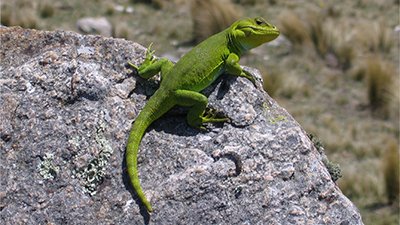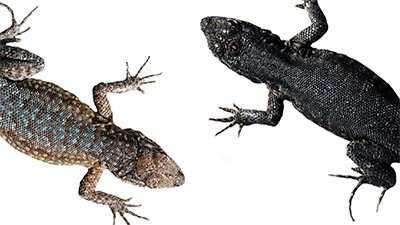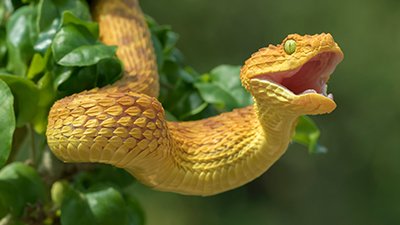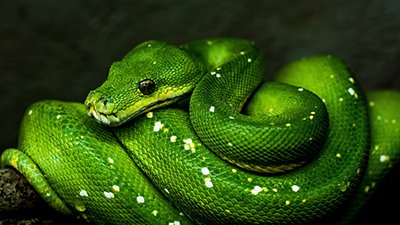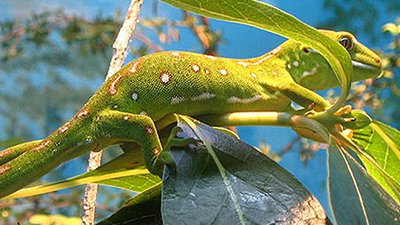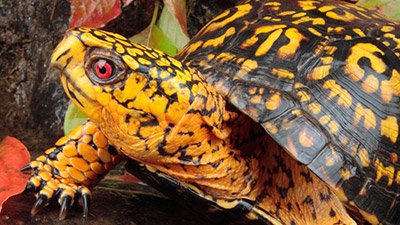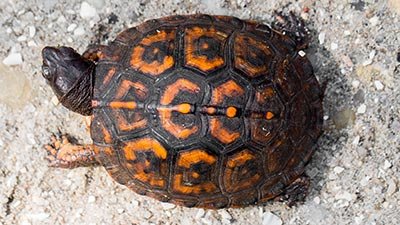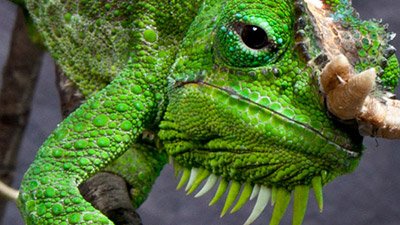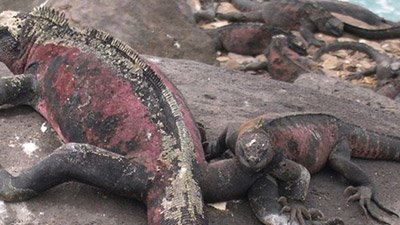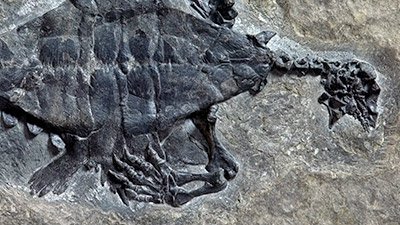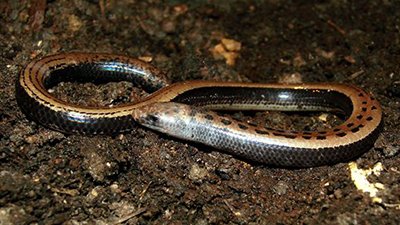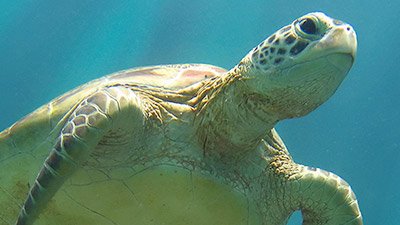Reptiles
Alligators
Two ingenious design features make the alligator a fearsome predator as he chases fish, birds, and small mammals. But alligators were not always meat-eaters. Like other predators in this now-fallen world, they continue to remind us about the Curse caused by Adam’s sin.
Turtles in the Winter
Box turtles truly take “hibernation” to another level. What special provision enables these four-legged tanks to endure subzero weather in such woefully shallow burrows? The answer sounds almost like science fiction. God equipped them with antifreeze!
Legs on a Snake?
A leg on a snake would not be a truly novel genetic feature, since there is evidence that the snake genome once had the information to produce legs. The leglessness of snakes today represents a corruption, loss, or deactivation of that information.
Chameleons: Walking Bug-Zappers
Stealth. Patience. Vigilance. Slowly the hunter moves unseen among the branches. His independently rotating eyes constantly scan the leafy canopy in every direction. No insect is safe within striking distance of his infamous weapon—a fast-acting and deadly accurate catapulting tongue. Aided by his steady grip and excellent vision, the chameleon is always ready to seize unsuspecting prey.
News About Reptiles
-
March 27, 2025 from Ken Ham Blog
How Fijian iguanas made the journey to the islands of Fiji has been a mystery in the evolutionary worldview—but researchers think they’ve solved the mystery.
-
Jan. 27, 2025 from Ken Ham Blog
According to reports, scientists are getting “front row seats of evolution unfolding in real time,” as two lizard species interact for the first time in Florida.
Articles About Reptiles
-
Feb. 16, 2025 from Answers Magazine
The existence of venom in so many animals has long challenged creationists. How did it show up in a very good creation?
-
Oct. 6, 2024 from Answers Magazine
Scientists studying a species in the Mojave Desert, known as side-blotched lizards, have learned that individual lizards can change coloring within a few weeks.
-
June 11, 2023 from Answers Magazine
A biblical perspective separates truth from myth about snakes.
-
May 1, 2022 from Answers Magazine
Horned lizards aren’t known for speed to avoid predators or venom to bring down threats. But these miniature dragons have tricks for desert survival.
-
Aug. 1, 2017 from 10 Cursed Creatures with Undeniable Design
The gecko is designed to climb. Scientists had to magnify the gecko’s foot thousands of times to find out its secret to defying gravity.
-
Jan. 7, 2017 from Answers Magazine
Eastern box turtles can literally be “frozen alive” and emerge unharmed.
-
Nov. 22, 2016 from Answers in Depth
Hailed as a transitional form between modern snakes and their supposed lizard ancestors, Tetrapodophis amplectus is now the subject of heated controversy.
-
Sept. 18, 2016 from Answers Magazine
You don’t have to travel to Paris to see one of the world’s greatest cathedrals. If you look carefully, one may be walking around in your own backyard.
-
Dec. 20, 2015 from Answers Magazine
Winged reptiles were primitive, clumsy, “prehistoric” beasts, barely able to get off the ground, right? Take a closer look and see.
-
Aug. 13, 2015 from Answers in Depth
Many evolutionists believe the discovery of a four-legged fossilized snake is evidence of a burrowing lizard in the snake’s evolutionary past, but is it?
-
In-Depth ArticleIs “Grandfather Turtle” the Transitional Form that Puts Creationist Claims to Rest?July 23, 2015 from Answers in Depth
With Pappochelys’s shell characteristics like those of other extinct turtles and a diapsid skull, should creation scientists be having nightmares?
-
June 14, 2015 from Answers Magazine
This issue of Answers in filled with muscular tools—many articles to help you on topics where the Bible is under attack.
-
Chameleons’ Color of Divine WisdomApril 18, 2015
Chameleons’ skin color can shift dramatically, and in just a few minutes their colors can revert back to the original. How do they do this?
-
March 26, 2015 from Answers in Depth
To evolutionists, the "butcher" crocodile demonstrates crocodiles had evolved to be major Triassic predators millions of years before dinosaurs ruled the world.
-
In-Depth ArticleIs Rapid Lizard Adaptation a Template for Deep-Time Evolution?Nov. 15, 2014 from Answers in Depth
Evolutionists declare stickier toes reveal the path up the evolutionary tree.
-
April 27, 2014 from Answers Magazine
A chameleon might look bizarre to you, but not to a bug.
-
Magazine Department ArticleThorny DragonJan. 1, 2014 from Answers Magazine
Ever race in the hot sun without a hydration pack? Well, you wouldn’t stand a chance against this scary-looking critter.
-
Fruit-Eating Crocodiles Dispel Carnivorous MisconceptionsDec. 2, 2013 from News to Know
Contrary to conventional wisdom, crocodilians not only can digest fruit but seem to commonly and intentionally consume it.
-
Magazine Department ArticleSnake MedicineApril 1, 2013 from Answers Magazine
Besides being the fastest land snake, the black mamba also has one of the fastest-acting snake vemons of any land snake.
-
Mamba Venom Derives from Gene DuplicationOct. 13, 2012 from News to Know
Venomous variations of nontoxic proteins and a potent painkiller in mamba venom point to variability available within created kinds.
-
A Snake Version of LucyAug. 4, 2012 from News to Know
“It’s the ‘Lucy’ of snakes,” claims Yale paleontologist.
-
Magazine Department ArticleVertebratesimalsJune 22, 2012 from Answers Magazine
In late 2011, scientists described a newly discovered chameleon species on Madagascar.
-
African Reptile First With a True PlacentaOct. 15, 2011 from News to Know
The skink that breaks the rules
-
May 29, 2011 from Answers Magazine
The marine iguana displays special design for sneezing excess salt.
-
-
The Legless SnakesFeb. 12, 2011 from News to Know
Why and how did “serpents” lose their limbs? The research may move forward, but the answer stays (largely) the same.
-
Magazine Department ArticleEvolution in (In)ActionDec. 27, 2010 from Answers Magazine
An Australian lizard can apparently either give live birth or lay eggs.
-
The Snake Can Walk?Sept. 19, 2009 from News to Know
A snake with a leg—is it evidence of evolution, creation, both, or neither?
-
Amazing Turtle Shell DevelopmentJuly 18, 2009 from News to Know
The incredible way a turtle develops a shell—is it an evolutionary accident or part of God’s design?
-
April 1, 2009 from Answers Magazine
Turtles are some of the most unique of God's creatures.
-
Snake Fangs and EvolutionAug. 9, 2008
If the riddle of where fangs fit into snake evolution has been gnawing at you, biologists may have come up with an answer.
-
The Danger of Komodo DragonsJune 14, 2008
The Komodo dragon is the world’s largest lizard. Recently, a group of stranded Britons had an encounter with a Komodo dragon that was reminiscent of a dinosaur-era battle.
-
Many Flying Reptiles Were CarnivorousMay 31, 2008
Mighty pterosaurs may have landed and strolled about on land when it was time to dine, reports LiveScience on a study published in PLoS ONE.
-
Sea Reptile is Now Largest on RecordMarch 1, 2008
Norwegian scientists have announced the largest marine reptile known to modern science, a fossil discovered in 2006 in Norway’s far-north Svalbard islands.
-
Oct. 1, 2007 from Answers Magazine
Researchers in India have discovered a lizard without limbs, and it looks virtually identical to a snake.
-
July 1, 2007 from Answers Magazine
Sea turtles are intriguing to watch and study. A look at the facts reveals that they have been around for thousands (not millions) of years.
-
Lopsided SnakesMarch 10, 2007
One of this week’s examples of “evolution” in action is Pareas iwasakii, the Japanese snake.
-
Snakes with Legs? A Preliminary ReplyMarch 20, 2000
Some preliminary thoughts about snakes with legs.
-
Magazine ArticleA Lizard on Your CeilingSept. 1, 1992, pp. 6–7
The gecko lizard can walk across your ceiling upside-down without falling off. How does it do tills? Until a few years ago scientists did not know, though they proposed several conflicting theories.
Recommended Resources

Answers in Genesis is an apologetics ministry, dedicated to helping Christians defend their faith and proclaim the good news of Jesus Christ.
- Customer Service 800.778.3390
- © 2025 Answers in Genesis


